Related Research Articles
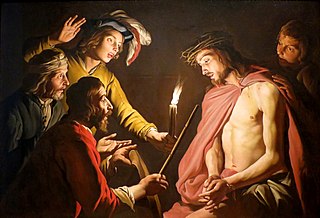
The Passion is the short final period before the death of Jesus, described in the four canonical gospels. It is commemorated in Christianity every year during Holy Week.
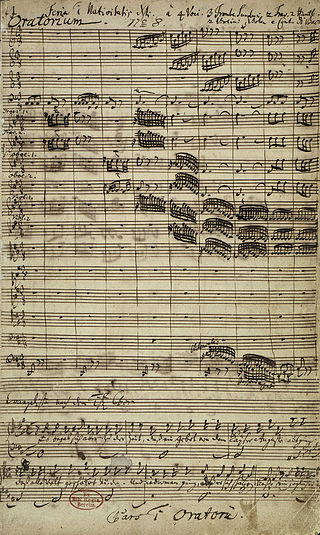
The Christmas Oratorio, BWV 248, is an oratorio by Johann Sebastian Bach intended for performance in church during the Christmas season. It is in six parts, each part a cantata intended for performance in a church service on a feast day of the Christmas period. It was written for the Christmas season of 1734 and incorporates music from earlier compositions, including three secular cantatas written during 1733 and 1734 and a largely lost church cantata, BWV 248a. The date is confirmed in Bach's autograph manuscript. The next complete public performance was not until 17 December 1857 by the Sing-Akademie zu Berlin under Eduard Grell. The Christmas Oratorio is a particularly sophisticated example of parody music. The author of the text is unknown, although a likely collaborator was Christian Friedrich Henrici (Picander).
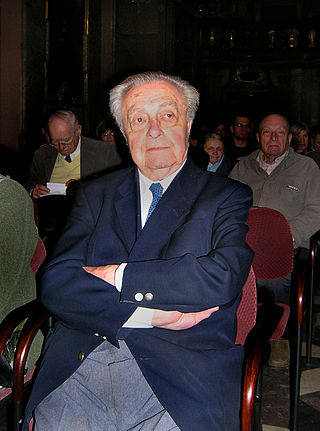
Ilja Hurník was a Czech composer and essayist.
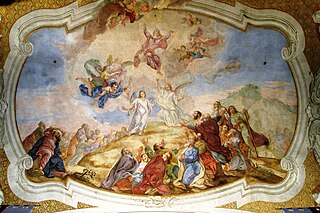
Lobet Gott in seinen Reichen, BWV 11, known as the Ascension Oratorio, is an oratorio by Johann Sebastian Bach, marked by him as Oratorium In Festo Ascensionis Xsti, composed for the service for Ascension and probably first performed on 15 May 1738.

Georgy Vasilyevich Sviridov was a Soviet and Russian neoromantic composer. He is most widely known for his choral music, strongly influenced by the traditional chant of the Russian Orthodox Church, as well as his orchestral works which often celebrate elements of Russian culture.

"O Sacred Head, Now Wounded" is a Christian Passion hymn based on a Latin text written during the Middle Ages. Paul Gerhardt wrote a German version which is known by its incipit, "O Haupt voll Blut und Wunden".

The cantatas composed by Johann Sebastian Bach, known as Bach cantatas, are a body of work consisting of over 200 surviving independent works, and at least several dozen that are considered lost. As far as known, Bach's earliest cantatas date from 1707, the year he moved to Mühlhausen, although he may have begun composing them at his previous post in Arnstadt. Most of Bach's church cantatas date from his first years as Thomaskantor and director of church music in Leipzig, a position which he took up in 1723.
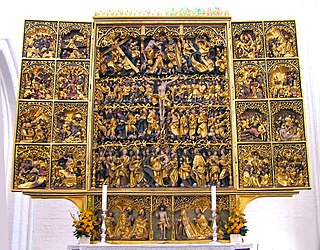
In Christian music, a Passion is a setting of the Passion of Christ. Liturgically, most Passions were intended to be performed as part of church services in the Holy Week.
Musical settings of sayings of Jesus on the cross are compositions which set seven short phrases uttered by Jesus on the cross, as gathered from the four Christian Gospels narrating the Crucifixion of Jesus. Several composers have written musical settings of the traditional collection of seven sayings, sometimes called Seven Last Words and ultima septem verba, for various combinations of voice and/or instruments. Eventually these settings became a separate form of Passion music. Perhaps the most outstanding work in this genre in the Lutheran tradition is the work by Heinrich Schütz. Joseph Haydn composed string quartets titled Die sieben letzten Worte unseres Erlösers am Kreuze.
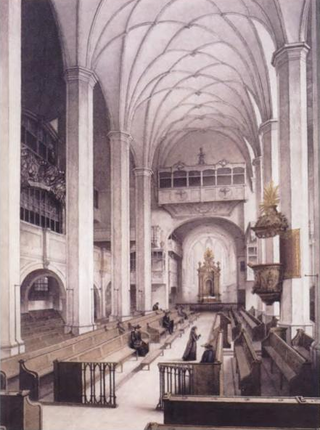
Johann Sebastian Bach composed the church cantata Allein zu dir, Herr Jesu Christ, BWV 33, in Leipzig in 1724 for the thirteenth Sunday after Trinity and first performed it on 3 September 1724. The chorale cantata is based on the hymn "Allein zu dir, Herr Jesu Christ" by Konrad Hubert (1540).

Vox Christi, Latin for Voice of Christ, is a setting of Jesus' words in a vocal work such as a Passion, an Oratorium or a Cantata. Conventionally, for instance in Protestant music of the Baroque era, the vox Christi is set for a bass voice.
As Thomaskantor, Johann Sebastian Bach provided Passion music for Good Friday services in Leipzig. The extant St Matthew Passion and St John Passion are Passion oratorios composed by Bach.

Der Tod Jesu is an oratorio libretto by Karl Wilhelm Ramler. In its setting by Carl Heinrich Graun in 1755, it was the most often performed Passion of the 18th century in Germany.

The Netherlands Bach Society is the oldest ensemble for Baroque music in the Netherlands, and possibly in the world. The ensemble was founded in 1921 in Naarden to perform Bach's St Matthew Passion on Good Friday and has performed the work annually since then in the Grote of Sint-Vituskerk. From 1983 until 2018, Jos van Veldhoven was the artistic director and conductor. Shunsuke Sato became artistic director in June of 2018 and resigned from the position in June of 2023.

Gelobet sei der Herr, mein Gott, BWV 129, is a church cantata by Johann Sebastian Bach. It is a chorale cantata performed on Trinity Sunday 8 June 1727 in Leipzig. Rediscovery of the printed libretto of the cantata in the first decade of the 21st century led to a re-appraisal of prior assumptions regarding the early performance chronology of a few cantatas, including this one.

Johann Sebastian Bach composed the church cantata Ach Herr, mich armen Sünder, BWV 135 in Leipzig for the third Sunday after Trinity and first performed it on 25 June 1724. It is the fourth chorale cantata from his second annual cycle, and is based on the hymn by Cyriakus Schneegass.

Johann Sebastian Bach composed the church cantata Herr Jesu Christ, du höchstes Gut, BWV 113 in Leipzig for the eleventh Sunday after Trinity and first performed it on 20 August 1724. The chorale cantata is based on the hymn "Herr Jesu Christ, du höchstes Gut" by Bartholomäus Ringwaldt (1588).
Johann Sebastian Bach's chorale cantata cycle is the year-cycle of church cantatas he started composing in Leipzig from the first Sunday after Trinity in 1724. It followed the cantata cycle he had composed from his appointment as Thomaskantor after Trinity in 1723.
Late church cantatas by Johann Sebastian Bach refers to sacred cantatas he composed after his fourth cycle of 1728–29. Whether Bach still composed a full cantata cycle in the last 20 years of his life is not known, but the extant cantatas of this period written for occasions of the liturgical year are sometimes referred to as his fifth cycle, as, according to his obituary, he would have written five such cycles – inasmuch as such cantatas were not late additions to earlier cycles, or were adopted in his oratorios.
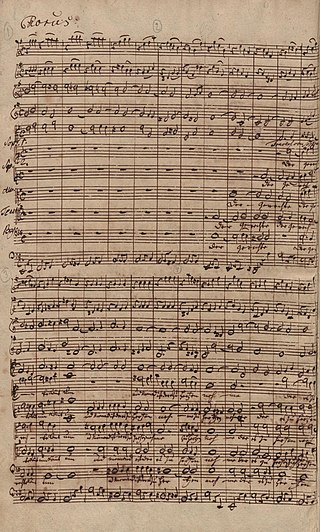
Der Gerechte kömmt um, BWV 1149, is a motet for SSATB singers and instrumental ensemble, which, for its music, is based on the five-part a cappella motet Tristis est anima mea attributed to Johann Kuhnau, and has the Luther Bible translation of Isaiah 57:1–2 as text. The arrangement of the Latin motet, that is, transposing it to E minor, adjusting its music to the new text, and expanding it with an instrumental score for two traversos, two oboes, strings and basso continuo, is attributed to Johann Sebastian Bach. The setting is found in a manuscript copy, likely written down in the 1750s, of Wer ist der, so von Edom kömmt, a Passion oratorio which is a pasticcio based on compositions by, among others, Carl Heinrich Graun, Georg Philipp Telemann and Bach. Likely Der Gerechte kömmt um existed as a stand-alone motet, for example for performance on Good Friday or at a funeral, before being adopted in the pasticcio.
References
- ↑ Pergolesi: Septem Verba a Christo – review Andrew Clements Thu 21 Mar 2013 "Until very recently, scholars have been unable to decide whether Pergolesi's cycle of Good Friday cantatas, based upon Christ's words on the cross, really was by Pergolesi at all. On the basis of the latest research, René Jacobs has no doubts about its authenticity, and considers the oratorio was probably written between 1730 and the composer's death six years later at the age of just 26."
- ↑ "The authorship of Septem verba a Christo in cruce moriente prolata has been disputed for more than a century. There is no firm evidence that Pergolesi was commissioned to compose this compact oratorio-like cycle of short cantatas contemplating the seven last sayings of Christ during the Crucifixion, so it seems an over-optimistic leap of conjecture to place much trust in the attribution to ‘Sig Pergolese’ found on several monastic manuscript sources made c1760 and preserved in Zurich and Munich. In 2009 another set of performing parts was rediscovered at Kremsmünster Abbey in Austria by musicologist Reinhard Fehling, whose critical edition is the basis for René Jacobs’s recording."